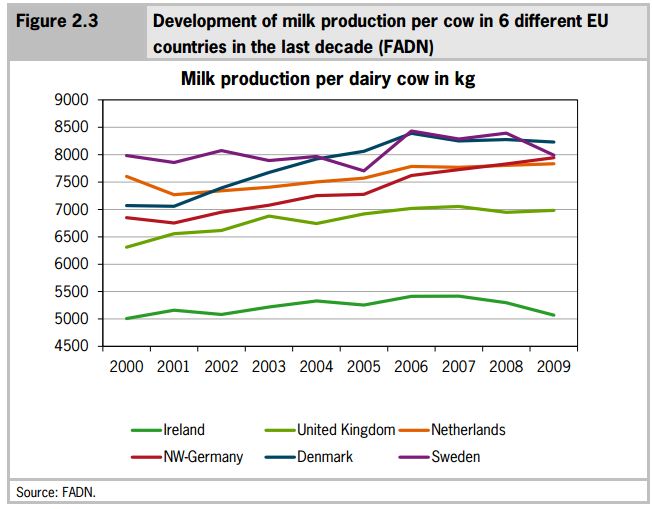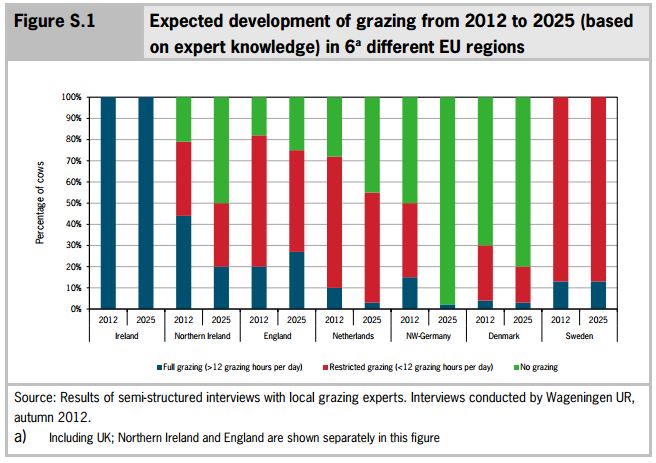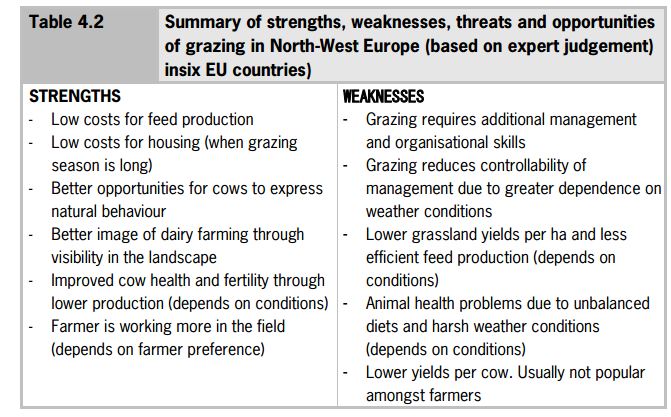



Grazing Dairy Cows in North-West Europe: Economic Farm Performance and Future Developments with Emphasis on the Dutch Situation
Grazing has been a tradition in European dairying for centuries but, a report from Wageningen University has elaborated on the speed in which indoor systems have gained popularity this century.Grazing is declining rapidly in Europe. In this study, which focused on 6 countries in North-West Europe, current estimations of grazing experts on the percentage of cows that graze, differ between 30 per cent in Denmark and 100 per cent in Ireland. The same experts predict that these percentages will be substantially lower in 2025 in North-West Germany, Northern Ireland, the Netherlands and Denmark.
Farm size
The average farm size, measured in terms of volume of milk produced is lowest in Ireland (almost 300 tonnes of milk in 2009) and highest in Denmark (more than 1,000 tonnes of milk in 2009), followed by the UK (Figure 2.1). The Netherlands, Sweden and North-West Germany take intermediate positions.
Many farmers expect to lower their fixed costs per kg of milk when increasing the total milk production on their farm. Automation and increase of productivity stimulate this development. In all countries, except for Denmark, milk production per farm has increased gradually in the period 2001-2009 (135 158 per cent).
In Denmark the average milk production per farm more than doubled (220 per cent) in this period. In Denmark financing for farm expansion could relatively simply be obtained and, more than in the other regions, farmers left the dairy business (amongst others because of good income in other sectors).
Farm Intensity
Farm intensity is expressed in this study as milk production per ha of forage crops on the own farm. This indicator gives an impression of the productivity of the land but may not be used as the sole indicator to evaluate productivity as there might be larges differences in use of purchased feed (both roughage and concentrates) between farms and countries.
Of the six countries/regions the Netherlands has the highest milk production per hectare of fodder crops (13 tonnes of milk per ha in 2009), showing a slight increase over the years. In Denmark farm intensity has increased to 12.5 tonnes of milk per ha in 2005 and 2006 but then decreased again to 11 tonnes per ha in 2009.
Sweden and Ireland have the lowest intensity: in these countries milk production per hectare of fodder crops fluctuates around 5-6 tonnes. The presence of sheep and beef cattle on dairy farms might be an important explaining factor for the low intensity in Ireland. In Sweden the short growing season probably plays a determining role.
The UK and North-West Germany take intermediate positions with approximately eight tonnes per hectare. Natural conditions for good forage production in own farmland are relatively good in the Netherlands and Denmark.
Furthermore, Dutch dairy farmers apply more manure and fertiliser and face lower prices per kg of concentrates than in the other regions/countries, due to lower transportation costs of overseas ingredients that arrive at the port of Rotterdam compared to other countries. Prices of purchased roughage tend to follow the prices of concentrates which eases the purchase of roughage in the Netherlands compared to other countries.
Milk Production per Cow
The amount of milk produced per cow is affected by the type of cow (breed and genetic potential), the diet of the cow and other farm management (quality of the stables, health management etc.). A high milk production per cow usually requires a higher share of concentrates in the diet and an increased attention for cow management.
Milk production per cow is with approximately 5,000-5,500 kg per year remarkably lower in Ireland compared to the other countries. This reflects the limited input of concentrates in Ireland, where the price of concentrates is relatively high. Sweden shows the highest milk production throughout this period (8,000-8,500 kg per cow per year), most likely as a consequence of a larger share of concentrates in the diet.
Denmark and North-West Germany both show quite a strong increase in milk production per cow in this period, indicating a shift towards systems with a higher productivity per cow. In the Netherlands the increase in milk production per cow is less pronounced. The UK takes an intermediate position between the Irish situation and the other countries.
Milk Price
The differences in farm income can partly be explained by differences in the revenues farmers receive for their milk. The milk price depends on the products that are produced from the milk and how well the chain is organised. Figure 2.5 shows that there are substantial differences in average milk output (measured as euro per 100 kg of milk produced) between the six countries/regions.
Farmers in Ireland and the UK received on average around €28 per 100 kg of milk over the period 2001-2009, whereas the average output for farmers in Denmark, Sweden and the Netherlands amounted up to €32-33. North-West Germany took an intermediate position with €29.8. More recent data (2010- 2012) extracted from the EU Agri database show the same ranking between these six countries (UK< Irl < Ger< Den< NL< Sw) (Dairy Co, 2013), though the Irish milk price seems to keep up with the German in current years.
Development of Grazing in the European Dairy Farmers Dataset
The EDF database supports a decrease in grazing over the last four years. Overall the percentage of EDF farms that applied grazing has dropped from 52 per cent in 2008 to 35 per cent in 2012. In Ireland all EDF farms apply grazing both in 2008 and 2012. In the UK the percentage of EDF farms that apply grazing has increased from 31 per cent in 2008 to 67 per cent in 2012. This increase is not the consequence of existing farms in the EDF group that have switched to grazing but new members that joined in that already applied grazing.
In Denmark none of the EDF farms applied grazing in 2008 nor in 2012. In the Netherlands (from 79 per cent to 51 per cent) and Germany (from 27 per cent to 11 per cent) the percentage of EDF farms that applied grazing dropped considerably in this period. In Sweden all farms apply grazing because it is mandatory. However, according to the definition used by EDF, the percentage of EDF farms in Sweden that apply grazing is low in both years (22 per cent and 13 per cent respectively) which indicates that fresh grass intake is limited.
Relation Between Grazing and Farm Structure in EDF Population
Though the EDF farms are generally much larger than the values reported by FADN, the EDF data confirm that grazing farms are generally smaller and less intensive and have a lower milk production per cow compared with non-grazing farms. On the other hand it can be observed that also in this population grazing exists in all size classes.
For the EDF sample as a whole, 43 per cent of the grazing farms produce more than 1.2m kg of milk per year. With respect to intensity (milk production per ha) and milk production per cow the differences between the countries are more explicit than the differences between grazing and the non-grazing groups within the countries.
Conclusions
The six studied countries/regions differ considerably in farm structure, grazing systems and costs of production. These differences have their origin in natural (soils and climate), economic and cultural circumstances. Natural conditions (mild climates, long growing seasons and soils not suitable for arable
production) are most favourable for grazing in Ireland and the UK and less favourable in Sweden and Denmark.
The Netherlands and North-West Germany take intermediate positions. Dairy farms are on average largest in the UK and Denmark and smallest in Ireland and Sweden. Dutch farms have the highest milk production per hectare (they produce and/or buy more feed), followed by the Danish.
Milk production per cow is lowest in Ireland and highest in Sweden. Denmark and North-West Germany show a more rapid increase in milk production than the other countries.
In general, grazing farms are smaller and produce less milk per cow and per hectare. However, grazing exists in all size classes. Grazing is rapidly declining in Denmark and North-West Germany and to a lesser extent in the Netherlands and the UK. In Sweden grazing is mandatory but grazing time and fresh grass intake is very limited. The Irish dairy sector is expected to completely maintain the full grazing system.
Despite the differences in natural conditions and farm structure, average net farm incomes (euro per annual work unit) are quite similar for the UK, Ireland, North-West Germany and the Netherlands. The factors behind these incomes differ between countries.
Ireland and the UK have a relatively low milk price. The share of costs directly related to milk production (feed and animal costs) is large due to high concentrate prices and as a result gross margins are low. Costs for buildings and machinery and contract work on the other hand, are low as well as the paid interest, labour and other costs.
These low fixed costs can 47 partly be explained by the full grazing systems in these countries. The other countries, where grazing time is much shorter, realise a higher milk price and better gross margins per kg of milk but on average higher indirect costs (costs for buildings and machinery, contract work, paid interest, labour and other).
The average net farm income in Sweden and Denmark are somewhat lower than in the other countries. Both countries have high direct and indirect costs compared to the other countries. The low income of Danish farms can primarily be attributed to the high interest costs. In Sweden the combination of high cost per litre of milk and small production volumes results in lower incomes.
The Future
Results of economic modelling also showed a strong tendency towards a decline of grazing on Dutch dairy farms. In the absence of intervention the model predicts a reduction from two-thirds of the cows grazing currently to one third in 2025.
This tendency is not inevitable and it can be counteracted by private and public policies aiming at higher percentages of grazing on dairy farms. To some extent, some of these measures are already being introduced in the Netherlands.
Expected Development of Grazing Towards 2025
After giving their opinion on the expected trends towards 2025, the experts were asked to make an estimate on how the distribution of milk and cows over the three grazing systems would look like in their region/country in 2025. These figures are presented compared to their estimate of the current situation. 67 The Irish expert expects that in 2025 all farmers are still working with the current full grazing system.
There is a general consensus that this is the most profitable system and the whole infrastructure is organised according to it. The estimate is that in 2025 100 per cent of the cows will still graze in Ireland. In the UK the experts expect that the three different systems will remain.
The expert in Northern Ireland thinks that the number of farmers with full grazing will decrease in favour of the number of non-grazing farms. The English expert predicts a decrease of the restricted grazing system in favour of the two extremes. The estimate is that 50 per cent of the cows in Northern Ireland and 75 per cent of the cows in England will still graze in 2025.
The Dutch experts expect that the number of grazing farms (both full and restricted grazing) will show a limited decline in favour of the non-grazing farms. The average estimate is that 55 per cent of the cows will still graze in the Netherlands in 2025, mostly in the restricted grazing system.
The German expert expects an almost complete disappearance of grazing. He thinks that in 2025 less than 5 per cent of the cows will be grazing in North-West Germany. The Danish expert expects that there will be a further decline in grazing (both full and restricted 68 grazing) in Denmark. His estimate is that in 2025 20 per cent of the cows in Denmark will still graze.
The Swedish expert did not predict the percentage of grazing cows in 2025. Whether grazing will decrease in Sweden will mainly depend on the development of the legislation on this topic.






